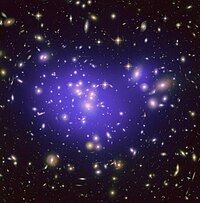
Photo from wikipedia
The role of baryonic physics, star formation and stellar feedback, in shaping the galaxies and their host halos is an evolving topic. The dark matter aspects are illustrated in this… Click to show full abstract
The role of baryonic physics, star formation and stellar feedback, in shaping the galaxies and their host halos is an evolving topic. The dark matter aspects are illustrated in this work by showing distribution features in a Milky Way sized halo. We focus on the halo morphology, geometry, and profile as well as the phase space distribution using one dark matter only and five hydrodynamical cosmological high-resolution simulations of the same halo with different subgrid prescriptions for the baryonic physics (Kennicut versus multi-freefall star formation and delayed cooling versus mechanical supernovae feedback). If some general properties like the relative halo-galaxy orientation are similar, the modifications of the gravitational potential due to the presence of baryons are found to induce different dark matter distributions (rounder and more concentrated halo). The mass density profile as well as the velocity distribution are modified distinctively according to the specific resulting baryonic distribution highlighting the variability of those properties (e.g inner power index from 1.3 to 1.8, broader speed distribution). The uncertainties on those features are of paramount importance for dark matter phenomenology, particularly when dealing with dark matter dynamics or direct and indirect detection searches. As a consequence, dark matter properties and prospects using cosmological simulations require improvement on baryonic physics description. Modeling such processes is a key issue not only for galaxy formation but also for dark matter investigations.
Journal Title: Journal of Cosmology and Astroparticle Physics
Year Published: 2023
Link to full text (if available)
Share on Social Media: Sign Up to like & get
recommendations!